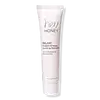What's inside
What's inside
 Key Ingredients
Key Ingredients

 Benefits
Benefits

 Concerns
Concerns

No concerns
 Ingredients Side-by-side
Ingredients Side-by-side

Water
Skin ConditioningPropanediol
SolventSodium Hyaluronate
HumectantGlycerin
HumectantButylene Glycol
HumectantPhenoxyethanol
PreservativeAmmonium Acryloyldimethyltaurate/Vp Copolymer
Leuconostoc/Radish Root Ferment Filtrate
AntimicrobialHyaluronic Acid
HumectantCarbomer
Emulsion StabilisingSodium Lactate
BufferingPolysorbate 20
EmulsifyingPalmitoyl Tetrapeptide-7
Skin ConditioningPalmitoyl Tripeptide-1
Skin ConditioningWater
Skin ConditioningCaprylic/Capric Triglyceride
MaskingAlcohol
AntimicrobialSorbitol
HumectantCetyl Alcohol
EmollientGlyceryl Stearate
EmollientGlycerin
HumectantHoney Extract
HumectantLonicera Japonica Flower Extract
Skin ConditioningSodium Polyacrylate
AbsorbentTocopheryl Acetate
AntioxidantSodium Stearoyl Glutamate
CleansingPropolis Extract
Skin ConditioningPhenethyl Alcohol
MaskingCimicifuga Racemosa Root Extract
AntimicrobialAloe Barbadensis Leaf Juice Powder
Skin ConditioningLactic Acid
BufferingLonicera Caprifolium Flower Extract
PerfumingWater, Caprylic/Capric Triglyceride, Alcohol, Sorbitol, Cetyl Alcohol, Glyceryl Stearate, Glycerin, Honey Extract, Lonicera Japonica Flower Extract, Sodium Polyacrylate, Tocopheryl Acetate, Sodium Stearoyl Glutamate, Propolis Extract, Phenethyl Alcohol, Cimicifuga Racemosa Root Extract, Aloe Barbadensis Leaf Juice Powder, Lactic Acid, Lonicera Caprifolium Flower Extract
 Reviews
Reviews

Ingredients Explained
These ingredients are found in both products.
Ingredients higher up in an ingredient list are typically present in a larger amount.
Glycerin is already naturally found in your skin. It helps moisturize and protect your skin.
A study from 2016 found glycerin to be more effective as a humectant than AHAs and hyaluronic acid.
As a humectant, it helps the skin stay hydrated by pulling moisture to your skin. The low molecular weight of glycerin allows it to pull moisture into the deeper layers of your skin.
Hydrated skin improves your skin barrier; Your skin barrier helps protect against irritants and bacteria.
Glycerin has also been found to have antimicrobial and antiviral properties. Due to these properties, glycerin is often used in wound and burn treatments.
In cosmetics, glycerin is usually derived from plants such as soybean or palm. However, it can also be sourced from animals, such as tallow or animal fat.
This ingredient is organic, colorless, odorless, and non-toxic.
Glycerin is the name for this ingredient in American English. British English uses Glycerol/Glycerine.
Learn more about GlycerinWater. It's the most common cosmetic ingredient of all. You'll usually see it at the top of ingredient lists, meaning that it makes up the largest part of the product.
So why is it so popular? Water most often acts as a solvent - this means that it helps dissolve other ingredients into the formulation.
You'll also recognize water as that liquid we all need to stay alive. If you see this, drink a glass of water. Stay hydrated!
Learn more about Water